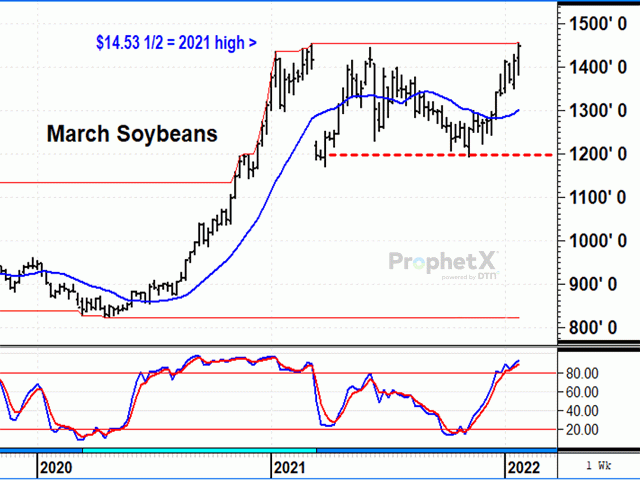March soybeans 1484'6 up 14'6
From DTM Progressive Farmer, January 28:
There is no question, the market that has had the most bullish surprises in the first four months of 2021-22 has been soybeans. And the kicker is this same market was looking convincingly bearish back in early November (see "Soybean Bears Emerge ... " at https://www.dtnpf.com/agriculture/web/ag/news/article/2021/11/05/soybean-bears-emerge-november-usda).

The chart above shows March 2022 soybeans have rallied from a low of $11.93 in early November to Thursday's close of $14.48 1/4, very close to the high of $14.53 1/2 that March soybeans reached in 2021. (DTN ProphetX chart by Todd Hultman)From the Sept. 30 Grain Stocks report to early November, USDA nearly doubled its estimate of U.S. ending soybean stocks in 2021-22 to 340 million bushels (mb), while China's soybean and meal prices broke lower and March soybean oil prices fell below their 100-day average.
Along with that, soybean prices in Brazil were showing no signs of stress and were actually making new lows. Brazil's soybean crops were successfully planted early in the fall and were enjoying good crop conditions. Looking back, it is odd how all those seemingly unrelated factors turned bearish at roughly the same time.
Fast forward to this week and we see a completely different set of market factors driving prices higher. The first bullish surprise emerged in December when soybean meal prices unexpectedly started trading higher. The market had known about a shortage of synthetic lysine for several months, but a sudden urgency of demand developed for cash meal prices in December. Meal prices were driven higher and enhanced the returns at soybean crush plants.
Also in December, murmurings started about dry weather conditions in southern Brazil. At first, the affected area appeared limited to Rio Grande do Sul, but by late December and early January it became apparent that other neighboring states and Argentina were also being affected. Brazil's soybean prices started perking up in January and added further support to U.S. soybean prices.
Throughout much of December, soybean oil prices kept a low profile, but that changed in late December and early January, encouraged by new highs in canola and palm oil. The Tuesday after Martin Luther King Jr. Day is when things really started picking up for soybean oil....
....MUCH MORE